![[VIDEO] Ultrasound-guided infiltration of the lumbar facets](https://drjordijimenez.com/imagen/100/100/imagenes-pagina/sindrome-facetario-lumbar-drjordijimenez (1).jpg)
- Home /
- EXERCISES /
- HIP EXERCISES /
- GLUTEUS MEDIUS STRENGTHENING EXERCISES WITHOUT OVERACTIVATION OF TENSOR FASCIAE LATAE
GLUTEUS MEDIUS STRENGTHENING EXERCISES WITHOUT OVERACTIVATION OF TENSOR FASCIAE LATAE
The Gluteus Medius and Hip Abductor Muscles
The gluteus medius and hip abductor muscles play a key role in pelvic stabilization and movement control during functional activities such as walking, running, or jumping. Weakness in these muscles can lead to biomechanical alterations that negatively affect not only the hip and knee joints, but also the lumbar spine, increasing the risk of dysfunction, pain, and injury.
A common consequence of gluteus medius weakness is overload of the tensor fasciae latae (TFL), a muscle that also acts as an abductor but lacks optimal stabilizing and biomechanical capabilities. When the gluteus medius is weak, the TFL tends to compensate, leading to excessive tension that may result in lateral hip pain, iliotibial band syndrome, and postural imbalances.
Therefore, it is crucial to differentiate and select strengthening exercises that activate the gluteus medius without overloading the TFL, promoting an efficient and balanced muscle activation pattern.
Specific strengthening of these muscles offers multiple benefits:
1. Improve pelvic and lumbar stability by correcting postural alterations like anterior pelvic tilt:
The gluteus medius plays a vital role in frontal and rotational control of the pelvis. Its weakness is often associated with anterior pelvic tilt, that is, excessive forward tilting of the pelvis, usually accompanied by lumbar hyperlordosis and muscle imbalances in the lumbopelvic region. This postural alteration compromises the effectiveness of the gluteus medius as a stabilizer and promotes compensations by the lumbar musculature and the tensor fasciae latae (TFL).
Proper strengthening of the gluteus medius helps restore greater postural control in both static and dynamic tasks, reduces anterior pelvic tilt, and improves lumbar alignment—key for pain prevention and optimal biomechanical function in daily and athletic activities.
2. Reduce dynamic knee valgus:
Weakness in the abductors is linked to increased medial knee collapse during running, jumping, or squatting. This misalignment increases stress on structures such as the anterior cruciate ligament (ACL) and the patellofemoral cartilage. Strengthening the abductors enhances neuromuscular control and promotes proper lower limb alignment.
3. Optimize functional performance and movement economy:
Proper control of the pelvis and hip allows for smoother, safer mechanics during dynamic tasks. This translates into greater efficiency, balance, stability, and lower energy expenditure, which is crucial both in sports and everyday life.
4. Reduce the risk of overuse injuries:
Dysfunctions in the lumbopelvic chain can lead to altered load transmission to the knee and spine. Strengthening the abductor muscles enhances load absorption and distribution, reducing the risk of chronic injuries in the knee, hip, and lumbar region.
5. Promote proper joint alignment:
Strong abductor muscles help maintain femoral centering in the acetabular socket and stabilize the lumbopelvic complex, preventing harmful movement patterns and protecting joint integrity.
Gluteus Medius Strengthening Exercises Without TFL Overactivation
Clamshell Exercise:
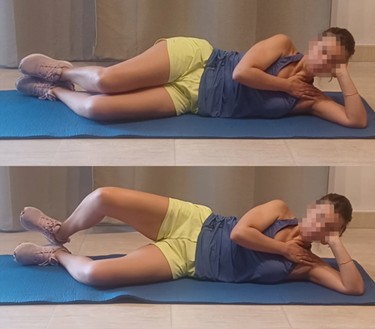
Lie on your side with your legs bent at 90 degrees and feet together. Keep the feet touching and open the top knee upward, like a clamshell. Lower slowly back down. Repeat several times and switch sides. If slight external hip rotation is maintained, TFL involvement is minimal.
Perform:
- 10 repetitions
- 3 sets
Goals:
- Activate and strengthen gluteus medius and minimus with minimal TFL activation
- Improve hip stability
- Prevent hip and knee injuries
- Correct muscular imbalances
- Improve alignment and posture while walking or running
Clamshells with Leg Extension:
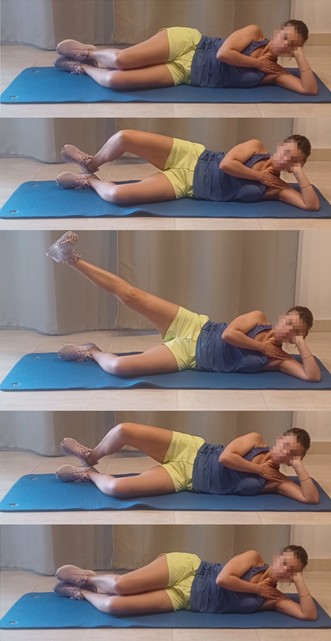
This is an advanced variation of the basic clamshell exercise. Lie on your side with legs bent at 90 degrees and feet together. Keep your head supported and engage your core. First, open the top knee while keeping the feet together, as in a clamshell. Then, extend the top leg outward until aligned with the hip. Return by bending the leg and lowering the knee to the starting position. Repeat before switching sides.
Perform:
- 10 repetitions
- 3 sets
Goals:
- Excellent for isolating and strengthening gluteus medius and maximus
- Improves control without involving the TFL if excessive hip flexion is avoided
- Enhances hip stability
- Prevents knee, hip, and lumbar injuries
- Improves mechanics for walking, running, or jumping
Bridge Exercise:
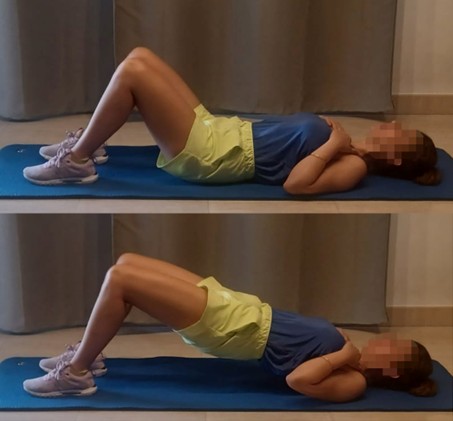
Lie on your back. Arms resting on the floor alongside the body. Knees bent with feet flat on the ground. Lift your hips upward until thighs align with the torso. Hold the position for 5 seconds. TFL is not activated if good alignment and gluteal contraction are maintained.
Perform:
- 10 repetitions
- 3 sets
Goals:
- Strengthen the gluteal muscles, mainly gluteus maximus, with co-activation of the gluteus medius
- Activate the hamstrings
Bridge with Leg Extension:
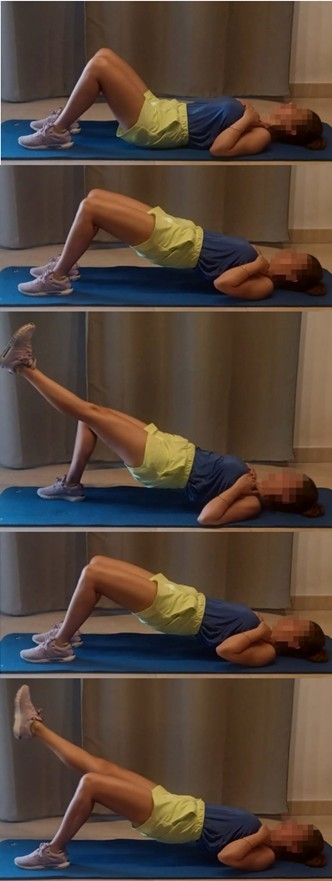
Lie on your back. Arms resting on the floor alongside the body. Knees bent with feet flat on the ground. Inhale and exhale as you lift your pelvis to align the thighs with the torso. Lift one foot with the knee straight. Hold the position for 5 seconds. Return to the starting position and repeat with the other leg. Advanced variation that activates the gluteus medius as a stabilizer. TFL activation is avoided with proper pelvic control.
Perform:
- 10 repetitions
- 1 set daily
Goals:
- Strengthen the core, gluteus maximus and medius, and hamstrings
- Improve spinal posture
- Enhance pelvic stability
Lateral Walk with Band on Forefoot:
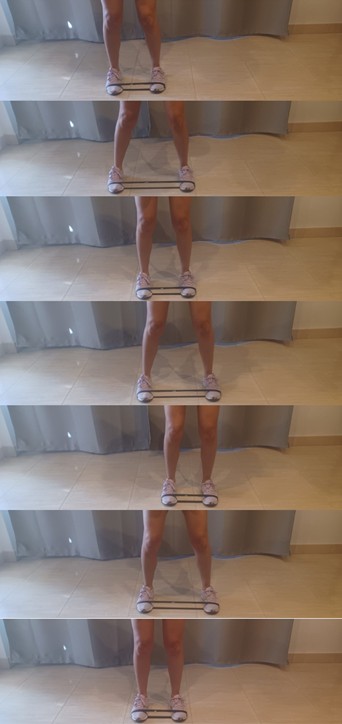
Take lateral steps while maintaining resistance with a band placed around the front of the feet (forefoot). Perform with slight flexion in knees and hips, with a straight trunk and activated core, maintaining constant band tension during movement. Provides greater gluteus medius activation with less TFL involvement compared to more proximal band placements.
Perform:
- 20 to 30 seconds per set or 8 to 12 steps each direction
- 2 to 3 sets daily
Goals:
- Activate and strengthen the glutes, especially the gluteus medius
- Prevent knee and lower back injuries
- Improve hip and pelvic stability
Lateral Step-Down Exercise:
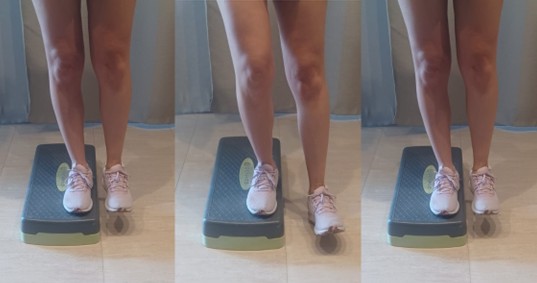
Step down to the side from an elevated surface (like a step or low box), controlling the motion without letting the heel touch the ground. Focuses primarily on one leg at a time, maintaining balance and alignment of the hip, knee, and ankle. Excellent for the gluteus medius. Minimal TFL activation with proper alignment.
Perform:
- 10 repetitions
- 2 to 3 sets daily
Goals:
- Strengthen quadriceps, gluteus medius, and maximus
- Prevent knee and hip injuries
- Improve balance and proprioception
- Enhance unilateral control and stability
Lateral Step-Down with Side Reach:
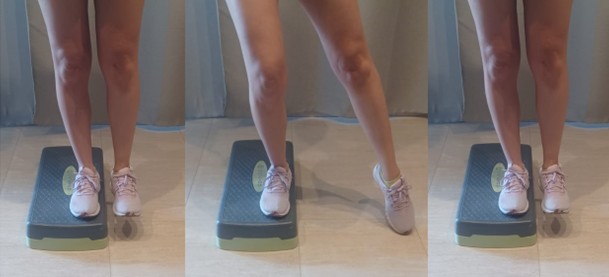
Variation of the traditional step-down. Stand on an elevated surface with one leg, and as you lower the opposite leg toward the ground, reach to the side and touch the floor with your toe (side reach), without losing balance or misaligning the hip or knee. Strengthens the gluteus medius and hip stabilizers without increasing TFL activity if done correctly.
Perform:
- 10 repetitions
- 2 to 3 sets daily
Goals:
- Strengthen gluteus medius, quadriceps, and hip stabilizers
- Improve balance and neuromuscular control
- Increase stability of hip, knee, and ankle
>> DOWNLOAD HERE THESE GLUTEUS MEDIUS STRENGTHENING EXERCISES WITHOUT TFL OVERACTIVATION HIP:  Exercises-gluteus-medius-without-TFL-overactivation-hip-drjordijimenez.PDF <<
Exercises-gluteus-medius-without-TFL-overactivation-hip-drjordijimenez.PDF <<
>> DOWNLOAD A HIP EXERCISE COMPLIANCE CALENDAR: hip-exercise-compliance-calendar-drjordijimenez.PDF <<
hip-exercise-compliance-calendar-drjordijimenez.PDF <<
Book an Appointment with Dr. Jordi Jiménez. He will attend you at the Palma de Mallorca center and help you recover your quality of life.

![[VIDEO] Ultrasound-guided infiltration of the hip joint](https://drjordijimenez.com/imagen/100/100/Imagenes/valgo-dinamico-rodilla-drjordijimenez.jpg)
